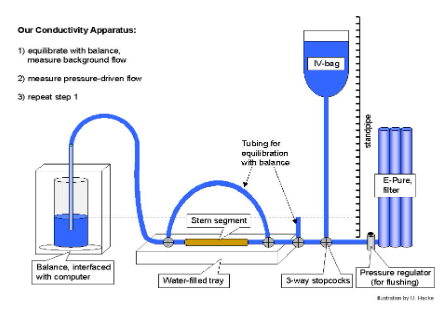Not Hydraulic but an Adsorption Water Transport occurs in the Xylem of Land Plants

Nature
The natural thermodynamic water transport by ad- and desorption forces at the stationary hygroscopic xylem/wood (Part of apoplast) of the intact plant body is described here. Contrary to the mechanic, hydraulic doctrine of textbooks, water in nature is held and moved at any plant height almost without tensile stress. It is well known that water enters the plant through a diffusion process (Osmosis) in liquid form, mostly via the root, and leaves it in vapor form via the leaf through diffusion (Transpiration). It is shown how the diffusive adsorption transport principle works. The partial dehydration (Desorption) of the plant, driven by transpiration, forms a combined concentration and adsorption-site gradient for water in the xylem matrix. Especially with open stomata a low moisture concentration and a high number of adsorption-sites for water (Sites with free van der Waals forces) can be found in the mesophyll cell walls (Part of apoplast) at the liquid - vapor boundary in the leaf. The water taken up by the root moves spontaneously (Adsorption) in the direction of this boundary and can thus partially or completely compensate the existing concentration- and adsorption-site differences for water. Physiologically an overlapping diffusive / adsorptive thermodynamic movement of moisture along the stationary hygroscopic xylem/wood takes place.

Textbook
Please click here for the original Preprint edition

Published at Preprints:
www.preprints.org
Please visit me on Twitter / Besuchen Sie mich bitte bei Twitter
Please visit me on Twitter / Besuchen Sie mich bitte bei Twitter
The fundamental error in the doctrine of hydraulic plant long-distance water transport under tension (“cohesion-tension theory”), is
the assumption that the elongated vessels of the xylem have the same physical properties as pipes and that a hydraulic flow according
to the Hagen-Poiseuille law (physics branch of mechanics) occurs within them. This is not the case.
For the empirical deduction of Hagen-Poiseuille’s law, they used watertight glass capillaries. The cells of the xylem, on the other hand,
consist of water-permeable and hygroscopic wall material (cellulose, hemicellulose and lignin). Therefore, the basic law of hydraulic flow, the continuity equation,
does not apply.
According to the continuity equation, the amount of fluid flowing into a pipe system per unit of time must be equal to the amount of fluid flowing out. This is not the case in the intact natural xylem, because its cell
walls react with the transported water. The “cohesion-tension theory” (hydraulic) doesn’t account for this fundamental property of the xylem!
Experimenters cut the xylem open and afterwards - imposed from the outside – they even try to determine a property of pipes, the “hydraulic conductivity”.
Experimental set up for the determination of “hydraulic conductivity” on a cut open plant stem segment e.g.: https://sperry.biology.utah.edu/methods.html

Cell walls, unlike the walls of pipes, can ad- and desorb different amounts of water.
These hygroscopic and anatomic properties of xylem cells, which are ignored by proponents of hydraulic flow in plants,
provide a clue to the natural, actual moisture transport principle: It is physically based on thermodynamic adsorption and
desorption of water in the xylem.
This is described in more detail in the Preprints article: “Not Hydraulic but an Adsorption Water Transport occurs in the Xylem of Land Plants”.
Contact
Karlheinz Hahn
Dipl.- Ing. FH; Dipl.- Biol. Univ
Vorrastraße 29
D - 90482 Nürnberg
E-Mail: karlhhahn@t-online.de
Website: www.k-hahn.de
Website Visits: 87737
